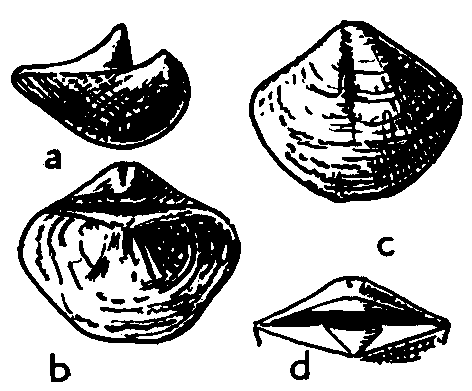
| Palaeos: |  |
Rhynchonelliformea |
| Brachiopoda | Kutorginida |
| Page Back | Page Up | Unit Home | Metazoa |
| Page Next | Page Down | Dendrogram | Glossary |
Classification from Treatise of Invertebrate Paleontology - Part H, Revised - Brachiopoda
Class KUTORGINATA Order Kutorginida Superfamily Kutorginoidea (Early to Middle Cambrian) Family Kutorginidae Superfamily Nisusioidea (Early to Middle Cambrian) Family Nisusiidae

The Kutorginoidea are the earliest brachiopod order which possesses a calcareous shell, and among the earliest of all brachiopod lineages. They were originally included in the Palaeotremata, a now discarded order that was erected for supposedly ancestral members of the Articulae lineage. They were then transferred to their own order (now considered a class) of Inarticulates. There is still considerable uncertainty over their taxonomic position. The most recent classification considers them Rhynchonelliform brachiopods (distantly allied to articulates).
The shell microstructure is fibrous and impunctate. The overall morphology is ventribiconvex, with a strophic (straight) hinge.
The pedicle valve has a prominent beak which curves over interarea of the brachial valve. It also possesses a supra-foramen and an interarea (or pseudointerarea) with a very wide triangular delthyrium, which resembles the billingsellacean articulates in that it is partially closed by a pseudo- deltidium. The brachial valve has a relatively prominent interarea and a plate, equivalent to the chilidium of other articulates, which closes the space beneath the beak. The valve interiors are poorly known and understood, and the teeth and sockets characterizing the articulates have not been positively identified.
The group is entirely limited to the early to middle Cambrian period, and does not appear to be closely related to other brachiopods. They are representatives of the first evolutionary wave of invertebrates (the Tommotian biota)

The Atdabanian epoch saw the emergence of the calcareous shelled Nisusiidae, the earliest and most primitive of the articulate brachiopods. The articulates are generally considered to have arisen from earlier inarticulates, although even in the earliest representatives of the group (Nisusia) possessed a well-developed hinge line and interareas. It is possible they developed from a biconvex obolid-like chitino-phosphatic stock, although this raises the biochemical problem of how the original calcium phosphate shell could change into one of calcium carbonate. Gutmann et al. (1978) have explained the development of the articulates as a gradual series of changes involving the development of the interarea and the improvement of the contact between the valves. Through hinge development, the comparatively bulky hydraulic valve opening mechanism could be reduced to a much smaller muscle system in the rear of the shell. This has the adaptive advantage of freeing two thirds of the space within the shell cavity for the function of food gathering by the lophophore. In any case, no transitional forms have been found.

Brachiopoda main page |